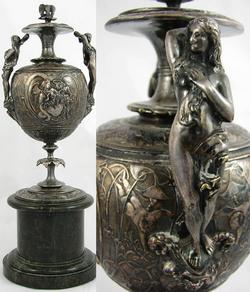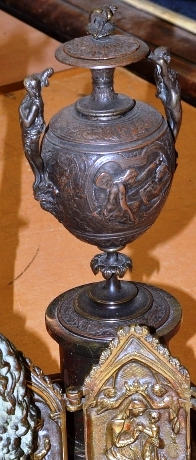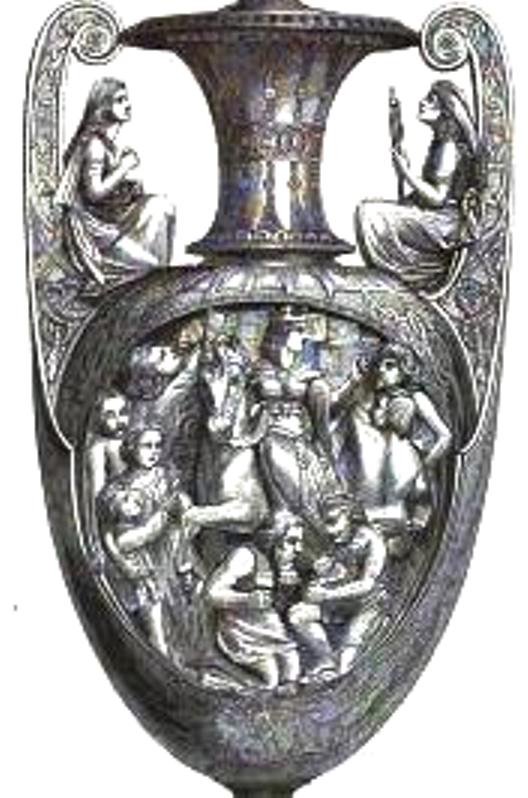Jes Barkentin
sculptor of
The Alexandra Vase
[HOME]
[POPULAR RETELLINGS]
|
The Alexandra Vase, presented to H. R. H. the princess of Wales by Danes resident in Great Britian. Designed by Jes Barkentin. Presented here through a series of contemporary reports: |
||||
|
||||
| HISTORICAL RECORD OP THE MARRIAGE OF H.R.H. ALBERT EDWARD, PRINCE OF WALES, WITH H.R.H. ALEXANDRA CAROLINE, PRINCESS OF DENMARK | ||||
|
Dec 1863, The London Star has been favored with a view of "the Alexandra vase," the wedding gift about to be presented to her Royal Highness the Princess of Wales by the Danes resident in Great Britain. The vase, which, with its base, is three feet six inches in height, is designed and wrought in oxydized silver, by Mr. JES BARKENTIN, of No. 23 Berners-street. The design itself is Danish in all respects. Subjects from Scandinavian history and mythology cover almost the entire surface of the vase, in the form of medallions on the sides, or in low, subdued relief on the intervening spaces; while the very chasing and minute ornamentation is in strict harmony with the wild, legendary character of the chief figures. Among the principal personages sculptured are the Fates, Deities and Heroes of the Walhalla, not forgetting those famous artificers the dwarfs. Among the historical subjects appear "Queen Thyra Dannebod superintending the building of the Dannervirke," and "Queen Dagmar interceding with her husband, Waldemar the Victorious, on behalf of the imprisoned peasants." The cover supports a statuette of Canute. On the stem of the vase are medallions of their Royal Highnesses the Prince and Princess of Wales; on the base are representations of "The Vikinger Fleet," a landscape in which are beheld a group of barrows and Druidical circles. Such are only a few of the subjects ingeniously designed and carefully elaborated by the Anglo-Danish artist. An explanatory inscription round the vase in Danish runs thus: "Brudegave til Danmarks Datter fra Danske mand og kvinder I Storbritanien," which means, when rendered into English, "Bridal gift to Denmark's daughter from Danish men and women in Great Britain." Royal Catalogue #651 Barkentin, J. & Slater, 291 Regent st. London, W.—Vases in oxydized silver, decorated with groups of figures, in repousse" work—subjects, Scandinavian mythology and "Cupid and Psyche;" also, contributed by H. R. HIGHNESS THE PRINCESS OF WALES, The Alexandra Vase, the wedding gift presented to Her Royal Highness by the Danes resident in England, designed and produced by Mr. J. Barkentin.
With its base and plinth the Alexandra Vase is three feet six inches in height, and it weighs about three hundred and fifteen ounces. In the great medallion, which appears upon the body of the vase in our engraving, Queen Thyra Dannebod is represented sitting on horseback, superintending the building of the Dannevirke, and encouraging the workers in their labour.
The corresponding medallion on the opposite side of the vase is devoted to the representation of a memorable incident associated with another royal lady, who, like Queen Thyra, may be styled a national heroine of Denmark. Queen Dagmar has been represented by Mr. Barkentin as in the act of interceding with her husband, Waldemar the Victorious, on behalf of the imprisoned peasants. Seated within the handles, the figures of Idun and Freia are introduced; and the cover supports a statuette of Canute. Mr. Barkentin has placed the two other statuettes in full relief, which, with consummate artistic skill, bind together the crowning figure of Canute and the groups of the two medallions and the small heads in the boss of the stem of the vase. These two beautiful figures, which sit within the handles of the vase, are Idun, with the golden apples of perennial youth, the ambrosia of the Scandinavian immortals: and Freia, the Venus of the north, holding the fatal distaff with which she spins the thread of the married life of the children of men. Conceived with genuine Scandinavian feeling, and executed with masterly power in repousse work of very low relief—the style of Art and the treatment arc most happily consistent with the myths that are shadowed forth below and between the two great medallions, and also ascending the outer faces of the handles of the vase, the other mythological figures appear grouped together in close succession. Below the Queen Thyra medallion, the three Norner, the Parcae of Scandinavia, appear seated under the shade of Ygdrasil, the sacred ash-tree that flourishes throughout space; and on the other side, occupying a corresponding position, the mystic triad, the supreme deities of the northmen, Odin, Vilé, and Ve, sit in solemn and lofty meditation. Upon each handle of the vase, soaring upwards, are the Valkyrier. the winged "shield maidens," who watch over the earthly career of the warriors of the north, and who also conduct their souls from their last battle-field to the Walhalla. Below them, on one side, standing on Byfrost, the bridge that spans the void between the Wallalla and the earth, is Heimdal the Vigilant, a cock on the crest of his helm, with his drawn sword, and blowing his horn — Odin's warder. Lower down, Odin himself sits enthroned, grasping his spear; on either Bide of him his two tamed wolves and his two ravens—the latter the emblems of the two great faculties of Reflection and Imagination. He contemplates the conflict ever raging between the Aserne and tho Jetterne. the gods and the giants, the adverse principles of good and evil; there, encircled by the club-wielding giants, and supported by his brethren, Thor, girded with his belt of strength, delivers crushing blows with Mjoelnir, his cross-formed hammer, short in the shaft. On the other side, enthroned like her lord, Frigga, queen of heaven, consort of Odin, mournfully contemplates the death of the best beloved of her sons, Balder the Beautiful, the god of wisdom and purity and the gentler virtues. As be lies dead at her feet, where he fell pierced by the arrow of mistletoe unwittingly shot at him by Hodur, his blind brother, Frigga conceives the idea that it may be possible to recall her Balder again to life; and, on the instant, she despatches Odin's chief minister Hermod, upon the good steed Sleipner, to confer with Hela, Queen of Helheim, where dwell apart the spirits of those Scandinavians who do not die in battle. Around the prostrate form of their brother stand Thor, and Ydun, and Brage, the poet god, with his harp; and Nanna, Balder's wife, is kneeling, as she knelt before she sank down dead upon her dead husband. At the base of the composition, their groups encircling the vase, the dwarfs Brok and Scindre and their brethren, the skilled artificers, are at work, forging in their mountain caves armour and weapons for the celestial warriors, and forming jewels for them also for their adornment. Mr. Barkentin has received the special permission of H.R.H. the Princess of Wales to reproduce the "Alexandra Vase," in either bronze or electro-silver, as an exact model of his original work. These reproductions, accordingly, may be always seen in the atelier of the artist, and they may there be obtained by persons who may desire to possess models of this noble and interesting work, one whereon much of old Danish poetry—curious in its legends —is figuratively inscribed. |
||||
|
The King of Denmark's marriage present was singularly interesting, and the following statement is an account of this appropriate cadeau:— "Dagmar, the 'Darling Queen' of Denmark, died in 1212, and was buried in Ringsted Church. She was carried to the grave adorned with a costly jewel, which lay on her breast. In the time of Christian V. when her tomb was opened, this cross was taken care of, and it is now one of the most precious objects preserved in the Museum of Northern Antiquities in this city. This golden cross, which is about an inch and a half long, and one inch broad, is covered with figures in enamel on both sides, and is supposed to be of Byzantine workmanship. On the front is Christ on the Cross, and on the back five half-length figures— Christ in the middle, Saint Basilius above, Saint John Chrysostomus below, Saint Mary on the left, and Saint John the Evangelist on the right. Golden screws fasten the two sides together, and the space within probably contains a splinter of the Holy Cross or some other relic. This splendid ornament has great artistic value, it being the only enamelled cross which is known to have been in existence previous to the year 1212. It is always beheld with veneration by the crowds who visit the museum, for it speaks of a lady beautiful beyond compare, who died in the bloom of youth, and who demanded neither goods nor gold, broad acres nor stones of price, as her wedding gift, but only asked Valdemar the Victorious, her lord and master, to free the peasantry from their plough-tax and the poor prisoners from their fetters. It was this same Queen who, according' to tradition, had never committed a greater sin than that on Sunday she once 'laced her silk sleeves small,' and of -whom the old Danish ballad sings, that though she lay 'dead on little Kerstin's arm when the King rode up the streets,' she woke up at the sound of Valdemar's and her maidens' prayers, to ask him 'Peace give to the outlawed men, free the prisoners from their irons.' If ever there was a woman regarded for centuries as holy, it was Queen Dagmar. Even down to the beginning of this century, when the farmer went to his bench in Ringsted Church, he first approached the three graves where lie Valdemar and his two wives, and said, 'Dagmar, hail! Bengerd, fie!' No one in Denmark has so long and so eagerly pursued and protected antiquarian studies and Danish national monuments as the present King. And he had the happy idea of adopting this famous cross as a motive for a rich diamond jewel which he gave to the Princess of Wales on her leaving the shores of her country. To lay hands on the original cross was, of course, not to be thought of; it is regarded by the people as a kind of palladium. But his Majesty had an exact copy made by his Court jeweller, Mr. Diderichsen. 'May Dagmar's cross,' said a Danish writer, whose hope was verified, 'be a happy symbol for her Royal Highness of the love and respect with which she will be received by the nation whose Queen she will one day be!'" During the entire forenoon of the 24th of February, the Princess of Wales continued to receive wedding presents and deputations, many from those we may emphatically term the people. However, the Princess did not alone receive, but gave, allotting 6,000 thalers on that same day as dowries to six brides belonging to the poorer classes. Amongst the presents brought on the 24th, we may mention a porcelain stand with rich figures from the Flora Danica, presented by a committee of ladies; a costly fan, by the maids of honour; old northern golden ornaments, by a committee from Palster; an English Bible 100 years old, by a schoolmaster from Palster; busts of her Royal Highness's parents, from a Jutland committee; a splendid pair of gold-embroidered shoes, from the shoemakers of the capital, &c. To these must be added: Prom her Majesty the Queen Dowager and their Royal Highnesses the Hereditary Prince and Princess, a large painting by Schott, representing a group of the Princess Alexandra's brothers and sisters. From the Landgrave of Hesse and several members of the Hessian family, golden ornaments, diadem, clasp, bracelets, rings, &c, in the old northern style, executed by the Court jeweller, Michelsen. From Baron Blixen Finecke and his lady, the Princess Augusta, a marble groug, two children kissing each other, one of the finest works ever executed by Bissen, the great Danish sculptor, and in the purest Carrara marble. From the Princess Augusta a prayer-book, with the twelve chief prayers of the English Church, painted after the middle ages by her Royal Highness on vellum, with a ground of gold and silver, splendidly bound in the old style by Michelsen. From proprietors of Danish estates: A marble group, Adam and Eve, executed by Jerichau. From the capital: A marble statue, Hebe, executed by Bissen. From some young ladies: an album, with views in Denmark, by the best Danish artists. From the Brothers Bing: two portrait medallions in porcelain, the Princess's grandfather and grandmother. From the marine painter Sorensen: a picture representing a part of Copenhagen and the Long line, as seen from the roads.
|
||||
|
Here are photographs of other similar pieces by
Barkentin which provide a more realistic image of what the
Alexandra Vase looked like: |
||||

 |
||||
[POPULAR RETELLINGS]


